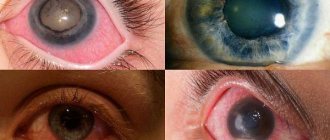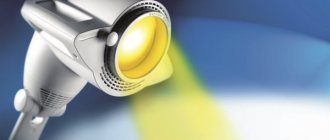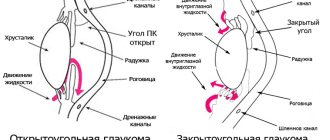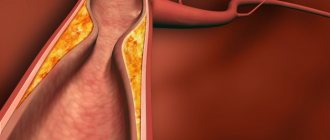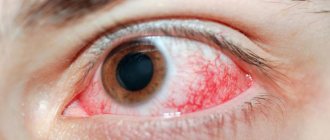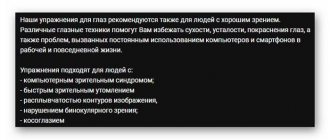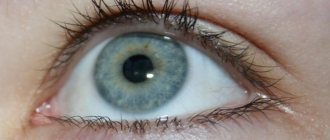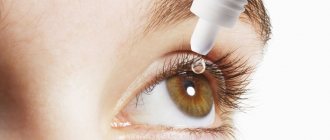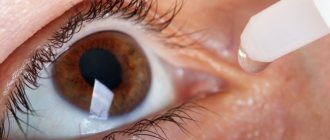Treating like with like was invented in the 18th century in Germany.
It is this principle that is hidden behind the famous word “homeopathy”.
Usually the term is associated with traditional medicine, treatment with natural ingredients and herbs.
But the difference between a homeopathic remedy and wormwood infusion is in concentration. In homeopathy, the infusion is diluted 1:10 or 1:100 from 3 to 12 times. The scientific community is skeptical about this dosage. The therapeutic effect of homeopathy is equivalent to placebo.
An alternative treatment method is also used in ophthalmology. Eye drops and solutions can be used in combination with the main treatment.
The effectiveness of homeopathy for eye diseases
Ophthalmic products in this category are designed to solve the same problems as medications: dry eyes, conjunctivitis, glaucoma, myopia, cataracts, blepharitis.
The advantages of homeopathic eye drops are the absence of chemicals, addiction, and side effects.
Theoretically, such eye drops, even if they enter the bloodstream, will not cause systemic disorders. They can be used during pregnancy, breastfeeding, the elderly and children. But each herb has properties that act specifically on the body. On the other hand, given the concentration of herbs in homeopathic drops, no side effects can be expected. As, probably, medicinal ones.
But consumer reviews say otherwise.
Homeopathy really helps
139 replies
Latest - November 12, 23:45 Go
Guest
It helps when there are no serious illnesses. Tuberculosis, cancer, female ailments, HIV, etc. cannot be cured by homeopathy, because in most cases it cures all self-hypnosis
Guest
it's like in Buratino'3 crusts of bread' and to them.....
Guest
written nonsense! Google about Madeleine Ennis, an ardent opponent of homeopathy. As for homeopathy, classical helps, when a specific medicine is prescribed to a specific patient. one! and homeopathy successfully treats small children and even animals... where does self-hypnosis come from?
Guest
placebo effect your homeopathy
Guest
Official medicine does not recognize homeopathy, and not without reason. With such a concentration of drugs used in homeopathy, any effect of the drugs is in question. For example, a dilution of 40C means a concentration of a solution at which one molecule of the active substance will be present in... the entire Universe accessible to observation.
You can just as easily drink a glass of regular boiled water. True, some modern homeopaths claim that water enhances the effect of the drug because it “has memory,” but such references to pseudoscientific ideas are all the more evidence against homeopathy.
Of course, the dilution index in homeopathic medicines is not always so high, but even with a smaller dilution, there may be more foreign impurities in the water than the active substance. In such cases there is no need to talk about any therapeutic effect. In some patients, the condition actually improves under the influence of homeopathic medicines.
But if the disease is not particularly serious, the human body can easily cope with the disease on its own, without any drugs, especially if the person sincerely believes that he is being treated (this is called the placebo effect). That is why in clinical trials of drugs, patients are divided into two groups - experimental and control.
There have been approximately 9,000 such clinical studies of homeopathic medicines, and none of them reported significant differences between the experimental and control groups.
Thus, homeopathy has no scientific basis. The action of homeopathic medicines is based solely on the placebo effect.
Guest
written nonsense! Google about Madeleine Ennis, an ardent opponent of homeopathy. As for homeopathy, classical helps, when a specific medicine is prescribed to a specific patient. one! and homeopathy successfully treats small children and even animals... where does self-hypnosis come from?
Guest
placebo effect your homeopathy
Guest
Once again for those who are not very smart: homeopathy is used to treat small children for all sorts of diathesis and dermatitis, when our “doctors”, at best, prescribe hormonal ointments that do not treat the disease, but drive it inside. How does a 2-3 year old child believe in placebo, please explain?
Guest
Homeopathy often refers to both classical homeopathy and herbal remedies. You need to read the composition of the medicine. If it is a herbal preparation, then it may well help, but calling it homeopathy is not entirely correct, even manufacturers often sin with this (valerian or St. John's wort can be called homeopathy, and they often do).
Therefore, before buying a drug, it is worth reading what it is. If a cough medicine based on licorice root extract helps you, and it is called homeopathy (because it is a natural component, not artificially created) - I believe it. But it’s just that pharmacists and manufacturers are even confused. Homeopathy itself is different.
author
Homeopathy is not a placebo. After taking the drug, a temporary deterioration in symptoms begins, because is based on the principle. I have already cured so many ailments and am incredibly happy about it. I am only for classical homeopathy, because a homeopathic doctor selects a drug that is suitable specifically for a particular person.
And I’m shocked about our medicine. For half a year I went from one doctor to another, a lot of ultrasound tests and everything else. As a result, they didn’t really explain anything, they prescribed pills that only made things worse. And after treatment with a homeopath, within a week I felt like a person, although before that everything from head to toe hurt, the condition was terrible.
Namely, blood pressure, lymph nodes, mastopathy, gastritis, the left lower abdomen hurt very badly (and the ultrasound said everything was ok), my arms and legs were constantly numb, hormonal imbalance, my face and body were covered with fluff. Maybe I even missed something. And I’m 28 years old and have this set. Naturally, in such a state there was depression and I felt like a wreck.
So don't write nonsense about fake science. It is not profitable for doctors to recognize homeopathy. The doctors themselves are treated by homeopaths and hide it (I know from medical friends). The main thing is to find a good homeopath who will choose the right treatment. And the treatment is not that expensive.
I paid so much money for going to doctors, it’s scary to count, but for taking a homeopath along with medications, 2500, I don’t think that’s expensive for my health.
Guest
Once again for those who are not very smart: homeopathy is used to treat small children for all sorts of diathesis and dermatitis, when our “doctors”, at best, prescribe hormonal ointments that do not treat the disease, but drive it inside. How does a 2-3 year old child believe in placebo, please explain?
True stories
Guest
Homeopathy is not a placebo. After taking the drug, a temporary deterioration in symptoms begins, because is based on the principle. I have already cured so many ailments and am incredibly happy about it. I am only for classical homeopathy, because a homeopathic doctor selects a drug that is suitable specifically for a particular person.
Homeopathic medicines depending on the pathology
Alternative means are used in courses. Most medications relieve dry and irritated eyes.
Inflammatory diseases
These include iridocyclitis, iritis, keratitis, blepharitis. Homeopathic remedies that complement the main treatment:
- Ephralia - phytodrops. Ingredients: eyebright, calendula, supplemented with magnesia. The components are dissolved in saline and water. No dyes or preservatives. The product has an analgesic, calming effect, and relieves inflammation. Additionally protects the cornea from external negative influences. Contraindication: allergy to components. If it is not there, the drops can be used during pregnancy. They are allowed for children from 1 year.
- Oculus Edas-108 is a comprehensive universal product. Herbs in its composition: rue, echinacea, eyebright, infused with ethyl alcohol. Indications: disturbances of light perception, halos, photophobia, spasm of accommodation, ulcerative lesions of the eyelids and cornea, inflammation with edema. Drops are taken orally. The effect of the drug on the fetus is not known, so it should not be taken during pregnancy. Children are allowed at any age, but up to 2 years old, give 1 drop per day.
Cataract
Changes in the structure of the eyes require effective treatment. Homeopathic remedies do not have a quick effect. Delay may result in vision loss. Therefore, priority should be given to surgical and traditional treatment.
You can support your body in the following ways:
- Phosphorus - a phosphorus preparation improves peripheral blood circulation. Its action is directed against vascular thrombosis, which causes clouding of the lens. Indications: diabetic cataract.
- Sulfur is an aqueous solution of sulfur. An antibacterial agent relieves inflammation and increases tissue susceptibility to other substances. May cause worsening of symptoms. Not recommended for abscesses.
Conjunctivitis
The following will help relieve lacrimation and irritation:
- Okulohel is a German-made eye drop. The package contains 5 bottles of 0.45 ml. Herbs in the composition: spoonwort of the Brassica family, echinacea, eyebright, pilocarpus of the Rutaceae family. Concentration - 110.7 mg of each component in 1 bottle. Sodium dihydrogen phosphate binds them together and with saline solution. There are no preservatives. Indications: irritation, inflammation, allergies of the eyes and eyelids caused by external causes, as well as dryness and fatigue of the visual organs. The drops do not change consciousness. They are allowed to be used by pregnant women. Children are shown from infancy. Side effects are standard - hypersensitivity to the components.
- Efrasia - refers to ophthalmic drugs. The eyebright solution is supplemented with boric acid, preservatives potassium nitrate and sodium tetraborate. Indications: lacrimation, inflammation, allergic swelling of the eyelids as part of catarrhal conjunctivitis, as well as irritation from monitors, sea water, and difficult weather conditions. If you are pregnant, you should consult your doctor before use. Possible side effects: burning, debris in the eyes, blurred vision after instillation. Therefore, you should not drive during treatment.
Dry eye syndrome
The mentioned Oculoheel will help fix the problem. The second product with an unusual composition is Optique. The drops are produced by the French pharmaceutical company Boiron. Packaged in sterile, single-use ampoules. They are sealed in bags that are placed in cardboard packaging. 1 ampoule contains 10 drops of solution.
Composition: Calcarea are calcareous sea sponges whose skeleton consists of calcium carbonate. Plant components: cineraria of the Asteraceae family, eyebright. Additional components: solution of potassium chloride Kali Muriaticum, magnesia, solution of silicic acid Silicea.
The drug helps eliminate flickering before the eyes, redness, and burning. Allowed for use by children from 2 years of age.
Homeopathic therapy for patients with open-angle glaucoma
What causes blindness in glaucoma? What are the main directions of drug treatment for glaucoma? What is the advantage of using homeopathic remedies along with allopathic ones?
Despite the extensive arsenal of allopathic medications, advances in microsurgical and laser surgical interventions, the treatment of glaucoma remains a serious medical and social problem. The prevalence of glaucoma among people over 40 years of age in Russia and industrialized Western countries reaches 1.7% [8]. Therefore, the problem of conservative treatment of glaucoma is relevant. In recent years, interest in homeopathic treatment methods has increased significantly, making it possible to expand the arsenal of treatment for various diseases.
According to modern concepts, glaucoma is a chronic disease of the organ of vision, characterized by a constant or periodic increase in intraocular pressure (IOP) with the development of dystrophic disorders in the anterior outflow tract of aqueous humor, the retina and the optic nerve, causing the appearance of typical defects in the visual field and the development of marginal (glaucomatous) excavation of the optic nerve. It is noteworthy that visual functions often continue to deteriorate even with normalization of IOP, and the direct cause of blindness in glaucoma is the pathology of the optic nerve, the atrophy of which occurs due to deterioration of its blood circulation [1, 6, 15]. Currently, it is customary to classify primary open-angle glaucoma (POAG) as a multifactorial disease [1, 13]. In the pathogenesis of POAG, a certain role belongs to genetic, biomechanical, immunological and biochemical factors, the state of the trabecular meshwork, and the ratio of intracranial and intraocular pressure. According to modern views, the leading factors in the pathogenesis of glaucoma are hemodynamic disturbances not only in the anterior segment of the eye, but also in the retina and optic nerve [1, 7, 15].
Currently, the study of the central mechanisms of IOP regulation continues. The role of dysfunction of the hypothalamus, limbic structures, and stress is being studied [14].
The importance of emotional stress factors in the etiology and pathogenesis of glaucoma is beyond doubt. However, in many cases the disease occurs and develops unnoticed by the patient. Often, only significant changes in the visual field (corresponding to the second or third stage of the disease) force the patient to consult a doctor. This is the uniqueness and insidiousness of the disease. At the same time, the diagnosis of glaucoma itself is a stressful factor for the patient due to the possible development of blindness.
Drug treatment of glaucoma is carried out in three main areas: - ophthalmic hypotensive therapy (local and general) in order to normalize IOP; - therapy that helps improve blood supply to the inner membranes of the eye and the anterior part of the optic nerve; - therapy aimed at normalizing metabolism in the tissues of the eye in order to influence the degenerative processes characteristic of glaucoma [9].
Over the last century, in the treatment of glaucoma, along with allopathic ones, various homeopathic drugs have been used: Aconitum, Aurum, Arnica, Lachesis, Ruta, Sulfur, Nux vomica, Belladonna, Gelsemium, Ignatia, Conium, Natrium mureaticum and others. In this case, homeopathic remedies with both constitutional and drainage and organotropic effects were used [4]. The pathogenetic basis and clinical effectiveness of the homeopathic method of treatment in ophthalmology have not been sufficiently studied.
Our clinic conducted a study to select pathogenetically oriented homeopathic medicines and study their effect on the dynamics of visual functions.
The treatment included 64 patients aged from 51 to 89 years with POAG (first to fourth stages) and various concomitant pathologies: hypertension, cerebral atherosclerosis, diabetes mellitus and other diseases. 10 patients had aphakia (13 eyes), of which 5 had cataracts in the fellow eye; pseudophakia - in 8 (10 eyes), and in 5 of them, cataract maturation in the other eye; initial or immature cataract - in 23 (43 eyes). Thus, in the majority of patients - 50 (78.1%) in 74 eyes (57.8%) - glaucoma was complicated by lens opacification. In 34 (53.1%) patients, 48 eyes had previously undergone antiglaucomatous operations.
In all patients, visual acuity was determined, and the visual field at the hemispheric perimeter was examined. Biomicroscopy, ophthalmoscopy, tonometry and tonography, and gonioscopy were performed. In addition, the central field of view on the Humphrey computer perimeter was examined. The duration of observation ranged from three months to two years.
In most patients, IOP was compensated and did not exceed 25 mmHg. Art. However, in 14 (21.9%) patients, an increase in IOP was noted in one of the previously operated eyes (up to 38 mm Hg). During treatment, the IOP decreased in most of them. The average IOP value before treatment was 22.68 mm Hg. Art., after - 20.98 mm Hg. Art. In 7 patients, episodic increases in IOP were observed. All patients had previously been treated for POAG in various medical institutions for 1–16 years. All patients continued to use (instill) previously prescribed antihypertensive drugs (arutimol, timolol, pilocarpine or their combinations). Patients were monitored every two to three weeks for the first 3 months, then every one and a half to two months.
As a basic remedy, 25 patients initially used the complex homeopathic drug traumeel, which affects all main types of metabolism. Traumeel was prescribed one tablet under the tongue three times a day for a month [11]. At the same time, in 9 patients, the dynamics of changes not only in visual functions, but also in biochemical and immunological parameters were studied. As our research has revealed, the use of traumeel and other homeopathic remedies in most cases leads to: - a decrease in cholesterol levels without the use of any special diets or cholesterol-lowering drugs; - to the normalization of altered indicators of T-cell and humoral immunity and autoimmune disorders, which characterizes the immunomodulatory effect of homeopathic treatment [12].
Then, in the remaining 39 patients, instead of Traumel, two monopreparations Sulfur (sulfur) and Phosphorus (phosphorus) were used sequentially as a basic agent. Sulfur was used at the first dose, after a homeopathic survey and ophthalmological examination, in a 30-hundredth potency, three grains at a time. Then Phosphorus was prescribed in the 6-hundredth potency, three to five grains under the tongue three times a day for a month. Why were these particular drugs chosen?
The therapeutic effect of sulfur has been widely used in medicine since ancient times for diseases of the skin, joints and as a laxative. Organic sulfur compounds are widely used in sulfonamide drugs and methylthiouracil for thyrotoxicosis [3]. Sulfur often proves useful in the initial stages of treatment of chronic patients, who are almost always irritable and prone to depression. Sulfur affects the eyes with the following symptoms and conditions: rainbow circles around the lamp flame, opacities of the cornea and vitreous body, iritis, cataracts. Sulfur promotes the resorption of serous exudates and hematomas, is a catalyst for metabolism in the liver (reticuloendothelial system) and in the digestive organs; has a choleretic effect, reduces venous congestion in various organs (venotonic agent). It is used as a resorptive agent for all chronic exudates, as a reactive agent at the beginning of the treatment of all chronic diseases, and as an intermediate agent in non-reactive cases [2, 4, 15]. Among the links in the pathogenetic chain in glaucoma, an important place is occupied by hemodynamic disorders, which, according to a number of scientists, are leading in the pathological processes that arise in various structures of the eye. It has been shown that in glaucoma, not only the arterial inflow into the tissue is impaired, but also the venous outflow [7]. The normalizing effect of homeopathic medicines (including sulfur) was known 100 years ago. Indeed, unlike allopathic vasodilator medications, sulfur does not reduce blood pressure levels. It has now been established that after the irrational use of allopathic drugs, the perfusion pressure in the small vessels supplying blood to the anterior part of the optic nerve can significantly decrease. In addition, low systemic blood pressure against the background of mild intraocular hypertension can provoke ischemic damage in the tissues of the optic nerve head. This is observed not only with chronically low blood pressure, but also with hemodynamic crises, which can provoke glaucomatous damage to the optic nerve. Our experience indicates the effectiveness of sulfur in ocular pathology, however, the hemodynamic effect of sulfur needs further study.
Let us dwell on the physiological action of Phosphorus. Phosphorus in the form of phosphoric acid is part of phosphatase enzymes involved in fat metabolism and carbohydrate metabolism (synthesis and breakdown of starch and glycogen). Phosphorus is especially important for brain tissue and nerve cells. Phosphorus is part of cell nuclei, tissue fluids and affects all organs and main types of metabolism. Due to the versatility of its action in homeopathy, phosphorus is considered one of the cardinal remedies (polychrests) in the treatment of diseases of the nervous, skeletal and cardiovascular systems. Phosphorus is effective for cataracts, vitreous opacities, optic nerve atrophy, glaucoma, retinal vascular thrombosis and degenerative changes in retinal cells [2, 3, 5, 16]. As can be seen in our material, glaucoma is often complicated by clouding of the lens. Frequent progression of cataracts was also noted in operated glaucoma patients with normalized IOP and hypotension. Thus, phosphorus covers many of the main pathogenetic factors in the development of visual impairment in glaucoma.
Next, constitutional medications were individually selected for each patient. The duration of one course of treatment varied from one and a half to three months.
During the treatment process, almost all patients noted an improvement in general well-being, normalization of sleep, increased performance and resistance to external stimuli. A significant improvement in health status was noted in 43 (67.2%) patients. Positive treatment results - in the form of increased visual acuity - in 26 (40.6%) patients in 36 (28.1%) eyes; expansion of the peripheral boundaries of the visual field or a decrease in the number of relative and absolute scotomas was noted in 26 (40.6%) patients in 40 (62.5%) eyes. A simultaneous increase in visual acuity and improvement in the visual field was observed in 10 (15.6%) patients. The average IOP level before treatment was 22.7 mmHg. Art., after treatment it decreased unreliably to 21 mm Hg. Art. Stabilization of visual functions was noted in 27 (42.2%) patients in 45 (35.1%) eyes. Negative dynamics in visual functions occurred in 5 (7.8%) patients, of which an increase in IOP level occurred in 2 patients, which required surgical treatment despite the strengthening of local antihypertensive therapy.
We hypothesize that homeopathic medicines reduce complications associated with the use of topical antihypertensive drugs. For example, it is known that with long-term instillations of timolol (the vast majority of our patients received this particular drug), the following general complications were noted: from the central nervous system, depression, anxiety, diplopia, articulation disorders, obsessions, noise in the head, taste disturbances, transient headache, fatigue, memory impairment; from the cardiovascular system - bradycardia, arrhythmia, hypotension or hypertension; from the respiratory system - shortness of breath, bronchospasm. Complications from the eyes: rapid development of cataracts, hemorrhages in the macular area, etc. Traumeel, sulfur, phosphorus and other homeopathic drugs we use reduce the side symptoms caused by allopathic therapy. Therefore, it can be assumed that homeopathic medicines, when prescribed according to the law of similarity, can neutralize the side resorptive effects of auritimol (timolol) and other allopathic antihypertensive eye drops.
Thus, the data obtained indicate the clinical effectiveness, and therefore the prospects of using homeopathic medicines in the complex treatment of glaucoma in combination with local antihypertensive therapy.
Literature
1.
Borisova S. A. Ultrasound Doppler studies in the glaucoma clinic // Vest.
ophthalmol., 1998, No. 4, p. 52-55. 2.
Berike V. Materia medica of homeopathic preparations.
Smolensk: Homeopath. medicine. 1997, p. 487-488, 594. 3.
Vavilova N. M. Homeopathic pharmacodynamics.
Homeopathist. center, Smolensk; M. 1994, vol. 1, p. 166-173, 203-204. 4.
Konde L. A. Possibilities of using the homeopathic method in the treatment of patients with glaucoma // Mater.
intl. homeopathist. congress., dedicated 200th anniversary of homeopathy. Novosibirsk, 1996, p. 90-91. 5.
Kent J.T.
Materia Medica. M.: Ollo, 1999, vol. 2, p. 986-987, 1159. 6.
Krasnov M. M. On the analysis of the features of intraocular hemodynamics and the possibility of therapeutic effects on it in glaucoma and circulatory deficiency // Vest.
ophthalm. 1989, no. 6, p. 35-43. 7.
Krasnov M. M. On intraocular circulation in glaucoma // Ibid., 1998, No. 5, p.
5-7. 8.
Libman E. S., Shakhova E. V., Chumaeva E. A. Glaucoma as a medical and social problem // Glaucoma: Sat.
scientific tr. MNIIGB im. Helmholtz. M., 1998, p. 5-11. 9.
Morozov V.I., Yakovlev A.A. Handbook.
Pharmacotherapy of eye diseases. M.: Medicine, 1998, p. 303. 10.
Nepomnyashchikh V. A. Homeopathic treatment of patients with open-angle glaucoma.
Homeopathist. yearbook. M., 1998, p. 140-143. 11.
Nepomnyashchikh V. A. Treatment of patients with open-angle glaucoma using modern homeopathic medicines // Proc.
report Moscow intl. homeopathist. conf. M., 1998, p. 41-42. 12.
Nepomnyashchikh V. A., Zaitseva N. S., Teplinskaya L. E., Chesnokova N. B., Kuznetsova T. P. Experience in the use of homeopathic medicines in the treatment of certain types of ophthalmopathology // Act.
question ophthalm. Voronezh, 1998, p. 140-143. 13.
Nesterov A. P. Glaucoma.
M.: Medicine, 1995, p. 255. 14.
Ponomarchuk V. S. Glaucoma // Coll.
tr. MNIIGB im. Helmholtz. M., 1996, p. 23-29. 15.
Shmyreva V.F., Shershnev V.V., Mazurova Yu.V. Pathogenesis and treatment of low (normal) pressure glaucoma // Vest.
ophthalmol., 1998, No. 4, p. 47-48. 16.
Storch Gerwig. Homeopathic medicines for practice. Kyiv: Health, 1993, p. 59-61, 63-64.
Note!
- The prevalence of glaucoma among people over 40 years of age in Russia and industrialized Western countries reaches 1.7%
- In glaucoma, visual functions continue to deteriorate even with normalization of IOP, and the direct cause of blindness is pathology of the optic nerve
- In the pathogenesis of glaucoma, the leading factors are hemodynamic disturbances not only in the anterior segment of the eye, but also in the retina and optic nerve
- Drug treatment of glaucoma is carried out in three main areas: reducing IOP, improving hemodynamics and metabolism of eye tissue
- Homeopathic medicines have been suggested to reduce complications associated with the use of topical allopathic antihypertensive agents
Consumer Reviews
Anna: A friend recommended Okulokheel drops for eye fatigue. By the end of the working day, my eyes burned and were red. I tried a lot of products, so I didn’t have much hope for new drops. They are homeopathic, the composition is in Latin. But from the first time I felt relief. An excellent remedy.
Irina: Optique drops solve the problem of dry and irritated eyes in 5 minutes. The eldest daughter got an eyelash in her eye, it became swollen and red. After the drops, the swelling quickly went away. My youngest daughter started getting irritated after swimming in the pool. Also an instant effect. The youngest was not even 2 years old. According to the instructions, children can drip from this age. But there were no adverse reactions.
Vyacheslav: I recently learned about Efralia drops. I decided to try it for the vascular network on the whites of the eyes. Homeopathy, herbs - means safe. It really hasn't gotten any worse. I drip 3 times a day. The redness has decreased.
How to take it correctly
The drugs can be purchased in the form of a solution, ointment, or drops. But usually they are produced in the form of granules, which are made from lactose (sucrose may be present) impregnated with the main medicinal substance. When receiving, you must follow the following rules:
- there is no need to touch the granules with your hands - they need to be poured into a spoon and put into your mouth;
- preparations cannot be used immediately after toothpastes with aromatic additives or mouth rinses - you need to wait at least half an hour;
- You cannot take two medications at once - it is better to make an interval of 1-2 hours;
- the drug should completely dissolve in the mouth - there is no need to swallow or chew it immediately;
- It is better to take the product 30 minutes before a meal, or 60 minutes after;
- Shake the bottle of drops well before taking.
In severe cases of the disease, homeopathic medicines should be taken every 30-60 minutes (taking into account the general state of health). Once the desired result is achieved, no more medications should be taken. This is the main distinguishing feature from the usual medications, which must be taken in courses, even if your health has completely improved.
Prevention
Tip for preventing dry eye syndrome: if you work at a computer, take a break for 10-15 minutes every 40 minutes, use a humidifier.
In addition, in order to preserve vision for those who use lenses, it is necessary to strictly follow the rules of wearing and not use lenses for longer. The longer a lens is used, the more its surface structure changes. Microorganisms that constantly live on the surface of the eyeball can multiply on it and cause damage to the cornea and foci of inflammation.
This point is especially relevant in the summer, when people go to relax on the river, to the sea, or to the pool. Microorganisms that get under a contact lens can cause severe damage that results in decreased visual function. You can swim with your lenses in, but at the end of the day they must be removed and placed in a storage container.
